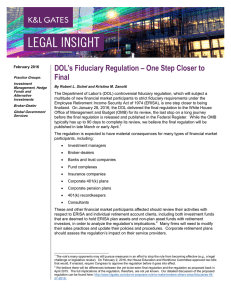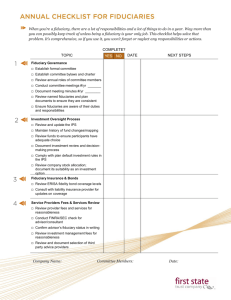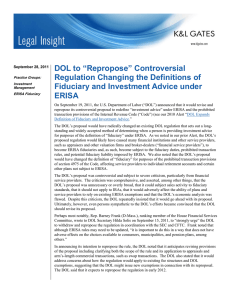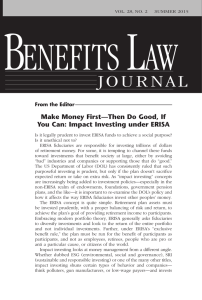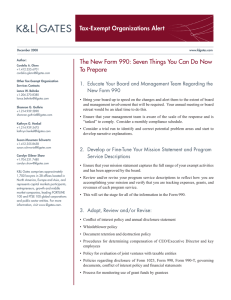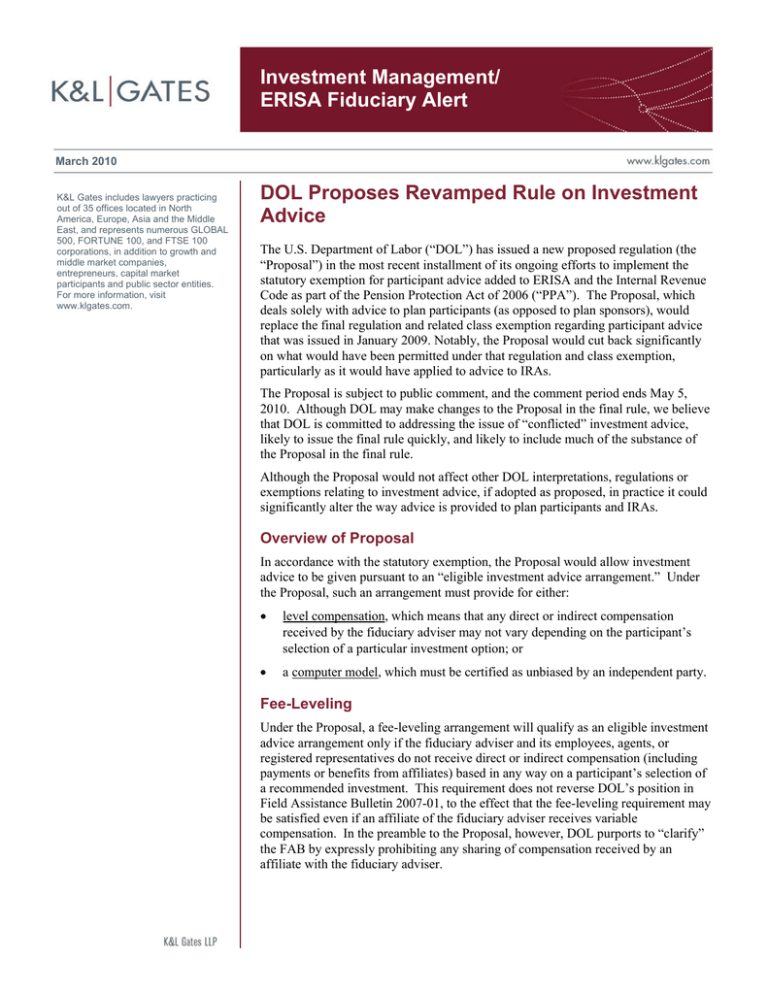
Investment Management/
ERISA Fiduciary Alert
March 2010
K&L Gates includes lawyers practicing
out of 35 offices located in North
America, Europe, Asia and the Middle
East, and represents numerous GLOBAL
500, FORTUNE 100, and FTSE 100
corporations, in addition to growth and
middle market companies,
entrepreneurs, capital market
participants and public sector entities.
For more information, visit
www.klgates.com.
DOL Proposes Revamped Rule on Investment
Advice
The U.S. Department of Labor (“DOL”) has issued a new proposed regulation (the
“Proposal”) in the most recent installment of its ongoing efforts to implement the
statutory exemption for participant advice added to ERISA and the Internal Revenue
Code as part of the Pension Protection Act of 2006 (“PPA”). The Proposal, which
deals solely with advice to plan participants (as opposed to plan sponsors), would
replace the final regulation and related class exemption regarding participant advice
that was issued in January 2009. Notably, the Proposal would cut back significantly
on what would have been permitted under that regulation and class exemption,
particularly as it would have applied to advice to IRAs.
The Proposal is subject to public comment, and the comment period ends May 5,
2010. Although DOL may make changes to the Proposal in the final rule, we believe
that DOL is committed to addressing the issue of “conflicted” investment advice,
likely to issue the final rule quickly, and likely to include much of the substance of
the Proposal in the final rule.
Although the Proposal would not affect other DOL interpretations, regulations or
exemptions relating to investment advice, if adopted as proposed, in practice it could
significantly alter the way advice is provided to plan participants and IRAs.
Overview of Proposal
In accordance with the statutory exemption, the Proposal would allow investment
advice to be given pursuant to an “eligible investment advice arrangement.” Under
the Proposal, such an arrangement must provide for either:
•
level compensation, which means that any direct or indirect compensation
received by the fiduciary adviser may not vary depending on the participant’s
selection of a particular investment option; or
•
a computer model, which must be certified as unbiased by an independent party.
Fee-Leveling
Under the Proposal, a fee-leveling arrangement will qualify as an eligible investment
advice arrangement only if the fiduciary adviser and its employees, agents, or
registered representatives do not receive direct or indirect compensation (including
payments or benefits from affiliates) based in any way on a participant’s selection of
a recommended investment. This requirement does not reverse DOL’s position in
Field Assistance Bulletin 2007-01, to the effect that the fee-leveling requirement may
be satisfied even if an affiliate of the fiduciary adviser receives variable
compensation. In the preamble to the Proposal, however, DOL purports to “clarify”
the FAB by expressly prohibiting any sharing of compensation received by an
affiliate with the fiduciary adviser.
Investment Management/ERISA Fiduciary Alert
A fee-leveling arrangement must also (1) be based
on generally accepted investment theories, (2) take
into account investment management and other fees
and expenses relating to the recommended
investments, and (3) take into account any pertinent
or personal information (such as age, time horizons,
risk tolerance, and other assets) provided by the plan
or the participant.
As a practical matter, the fee-leveling arrangements
described in the Proposal do not appear to add in any
meaningful way to what is already permitted under
prior DOL interpretations.
Computer Models
Under the Proposal, a computer model will qualify
as an eligible investment advice arrangement only if
the model:
•
applies generally accepted investment theories
that take into account the historic risks and
returns of different asset classes over defined
periods of time;
•
takes into account investment management and
other fees and expenses with respect to the
recommended investments;
•
takes into account any pertinent or personal
information (such as age, time horizons, risk
tolerance, and other assets) provided by the plan
or the participant;
•
uses appropriate objective criteria to provide
asset allocation portfolios made up of
investment options available under the plan;
•
does not inappropriately favor proprietary
investments of the fiduciary adviser or any
person with a material affiliation (in general, a 5
percent or greater ownership interest) or
material contractual relationship (contractual
relationships exceeding 10 percent of gross
revenue) with the fiduciary adviser;
•
•
does not inappropriately distinguish among
investment options within a single asset class on
the basis of a factor that cannot confidently be
expected to persist in the future;
takes into account all investment options
available under the plan, except the model is not
required to make recommendations regarding
(1) investments primarily in employer
securities, (2) target date or balanced funds, or
(3) annuities; provided that, with respect to
target date or balanced funds and annuities, the
participant is also given a general description of
such funds or annuities and how they operate;
and
•
does not give inappropriate weight to any
investment option.
In addition, the computer model must be certified,
in writing, by an “eligible investment expert” prior
to the provision of any advice pursuant to the
exemption. This certification must identify and
explain the methodologies used in the computer
model and describe any limitations imposed on such
methodologies. The “eligible investment expert”
must be a person with appropriate technical training
or experience and proficiency, and must so
represent in writing. No person with any material
affiliation or material contractual relationship with
the fiduciary adviser can serve as an eligible
investment expert.
As stated above, the computer model may not
“inappropriately distinguish among investment
options within a single asset class on the basis of a
factor that cannot confidently be expected to persist
in the future.” In the preamble to the Proposal,
DOL indicates that this limitation is intended,
among other things, to prohibit the use of
“differences in historical performance” in a
computer model. Although DOL specifically
invites comments on this point, this aspect of the
Proposal, if adopted, could severely disadvantage
actively managed funds. On the other hand, DOL
may have something more limited in mind. This
issue is likely to be the subject of spirited comment
and discussion.
General Requirements Applicable to
Both Fee-Leveling and Computer
Models
Both types of arrangements must:
•
be authorized by an independent plan fiduciary
or IRA beneficiary;
•
be subject to an annual audit by an independent
auditor; and
March 2010
2
Investment Management/ERISA Fiduciary Alert
•
provide required disclosures. The appendix to
the Proposal contains a model disclosure form.
In addition:
•
any actual investment transaction must occur
only at the direction of the advice recipient;
•
the fiduciary adviser may receive only
reasonable compensation; and
•
the terms of the investment transaction must be
at least as favorable to the plan as an arm’slength transaction.
Withdrawal of Class Exemption
As noted above, the investment advice regulation
issued by DOL in 2009 included a class exemption
that extended the relief for investment advice to
circumstances beyond those described in the
statutory exemption. This class exemption would
have made it significantly easier to provide
investment advice, particularly relating to IRA
assets. Under the class exemption, IRA owners
would have been permitted to receive individualized
advice from a fiduciary adviser receiving variable
compensation if the IRA owner requested the advice
after receiving a computer model or specified
investment educational material. The Proposal does
not include any of the relief that would have been
provided by the class exemption.
Continued Reliance on Prior DOL
Guidance
It is encouraging that the Proposal specifically states
that none of DOL’s prior regulations, exemptions, or
other guidance on the provision of investment advice
is affected by the Proposal. Therefore, programs
that comply with prior guidance, such as the
SunAmerica advisory opinion (AO 2001-09A),
should continue to be compliant with ERISA.
be sufficient. Also, we believe that DOL is likely to
view advisory programs that meet the requirements
of the Proposal as the “gold standard” in this area.
*
*
*
Please contact any member of the ERISA Fiduciary
Group listed below if you have further questions.
Catherine S. Bardsley
catherine.bardsley@klgates.com
202-778-9289
Mark J. Duggan
mark.duggan@klgates.com
617-261-3156
John J. Nestico
john.nestico@klgates.com
704-331-7529
David E. Pickle
david.pickle@klgates.com
202-778-9887
William A. Schmidt
william.schmidt@klgates.com
202-778-9373
William P. Wade
william.wade@klgates.com
310-552-5071
Kristina M. Zanotti
kristina.zanotti@klgates.com
202-778-9171
However, only eligible investment advice
arrangements that meet the requirements of the
Proposal would provide plan sponsors and other
fiduciaries with the relief from fiduciary liability
accorded by section 408(g)(10) of ERISA, which
was enacted as part of the PPA. It is too early to tell
whether plan sponsors will insist that investment
advice programs comply with the new regulations as
a condition to implementing participant advice
programs or whether relying on prior guidance will
March 2010
3
Investment Management/ERISA Fiduciary Alert
Anchorage Austin Beijing Berlin Boston Charlotte Chicago Dallas Dubai Fort Worth Frankfurt Harrisburg Hong Kong London
Los Angeles Miami Moscow Newark New York Orange County Palo Alto Paris Pittsburgh Portland Raleigh Research Triangle Park
San Diego San Francisco Seattle Shanghai Singapore Spokane/Coeur d’Alene Taipei Tokyo Washington, D.C.
K&L Gates includes lawyers practicing out of 35 offices located in North America, Europe, Asia and the Middle East, and represents numerous
GLOBAL 500, FORTUNE 100, and FTSE 100 corporations, in addition to growth and middle market companies, entrepreneurs, capital market
participants and public sector entities. For more information, visit www.klgates.com.
K&L Gates is comprised of multiple affiliated entities: a limited liability partnership with the full name K&L Gates LLP qualified in Delaware and
maintaining offices throughout the United States, in Berlin and Frankfurt, Germany, in Beijing (K&L Gates LLP Beijing Representative Office), in
Dubai, U.A.E., in Shanghai (K&L Gates LLP Shanghai Representative Office), in Tokyo, and in Singapore; a limited liability partnership (also named
K&L Gates LLP) incorporated in England and maintaining offices in London and Paris; a Taiwan general partnership (K&L Gates) maintaining an
office in Taipei; a Hong Kong general partnership (K&L Gates, Solicitors) maintaining an office in Hong Kong; and a Delaware limited liability
company (K&L Gates Holdings, LLC) maintaining an office in Moscow. K&L Gates maintains appropriate registrations in the jurisdictions in which its
offices are located. A list of the partners or members in each entity is available for inspection at any K&L Gates office.
This publication is for informational purposes and does not contain or convey legal advice. The information herein should not be used or relied upon
in regard to any particular facts or circumstances without first consulting a lawyer.
©2010 K&L Gates LLP. All Rights Reserved.
March 2010
4

